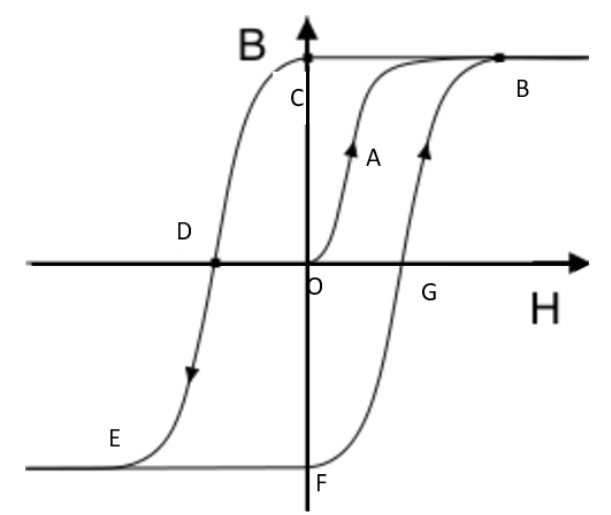
Write any three differences between paramagnetic and ferromagnetic materials. Explain magnetic hysteresis by drawing a hysteresis loop.
Answer
555k+ views
Hint: Aluminium, manganese, chromium and platinum are some examples of paramagnetic substances. Iron, nickel, cobalt, gadolinium, dysprosium and their alloys are a few examples of ferromagnetic materials. Magnetic Hysteresis Curve tells the relation between $B$ and $H$ in ferromagnetic materials which is complex. It is sometimes not linear and it depends on the magnetic history of the material.
Complete step by step answer:
Substances which are weakly attracted by a magnet are referred to as paramagnetic substances. The substances which are strongly attracted using a magnet are referred to as ferromagnetic substances. Paramagnetic materials lose their magnetism when the external field is removed and therefore cannot be used to make permanent magnets. Ferromagnetic materials will have a small amount of magnetism left in the absence of external fields and therefore can be used to make permanent magnets. In paramagnetic materials, the susceptibility is small but positive. While in ferromagnetic materials. The susceptibility is positive but very high.
Suppose the material is not magnetised at first. We keep it in a solenoid and enhance the current through the solenoid. The magnetic field B in the material rises and saturates as represented in the curve OAB. This nature indicates the alignment and merger of domains until no further enhancement is possible. Finally we have to decrease $H$ and decrease it to zero. $H=0,B\ne 0$ is represented by the curve OC. The value of $B$ at $H=0$ is called retentivity. Then the current in the solenoid is reversed and slowly increased. Certain domains are flipped until the resultant field inside becomes zero. This is represented by the curve CD. The value of $H$ at D is known as coercivity. When the reversed current is increased, then we once again reach at saturation. The curve OD represents this. Then the current is decreased (curve EF) and reversed (curve EB). The cycle repeats itself. The correct answer is reached.

Note: Note that the curve OB does not retract itself as $H$ is reduced. For a given value of $H,B$ is not unique but depends on previous history of the sample. This phenomenon is known as hysteresis.
Complete step by step answer:
Substances which are weakly attracted by a magnet are referred to as paramagnetic substances. The substances which are strongly attracted using a magnet are referred to as ferromagnetic substances. Paramagnetic materials lose their magnetism when the external field is removed and therefore cannot be used to make permanent magnets. Ferromagnetic materials will have a small amount of magnetism left in the absence of external fields and therefore can be used to make permanent magnets. In paramagnetic materials, the susceptibility is small but positive. While in ferromagnetic materials. The susceptibility is positive but very high.
Suppose the material is not magnetised at first. We keep it in a solenoid and enhance the current through the solenoid. The magnetic field B in the material rises and saturates as represented in the curve OAB. This nature indicates the alignment and merger of domains until no further enhancement is possible. Finally we have to decrease $H$ and decrease it to zero. $H=0,B\ne 0$ is represented by the curve OC. The value of $B$ at $H=0$ is called retentivity. Then the current in the solenoid is reversed and slowly increased. Certain domains are flipped until the resultant field inside becomes zero. This is represented by the curve CD. The value of $H$ at D is known as coercivity. When the reversed current is increased, then we once again reach at saturation. The curve OD represents this. Then the current is decreased (curve EF) and reversed (curve EB). The cycle repeats itself. The correct answer is reached.

Note: Note that the curve OB does not retract itself as $H$ is reduced. For a given value of $H,B$ is not unique but depends on previous history of the sample. This phenomenon is known as hysteresis.
Recently Updated Pages
Master Class 12 Business Studies: Engaging Questions & Answers for Success

Master Class 12 Economics: Engaging Questions & Answers for Success

Master Class 12 English: Engaging Questions & Answers for Success

Master Class 12 Maths: Engaging Questions & Answers for Success

Master Class 12 Social Science: Engaging Questions & Answers for Success

Master Class 12 Chemistry: Engaging Questions & Answers for Success

Trending doubts
What are the major means of transport Explain each class 12 social science CBSE

Which are the Top 10 Largest Countries of the World?

Draw a labelled sketch of the human eye class 12 physics CBSE

How much time does it take to bleed after eating p class 12 biology CBSE

Explain sex determination in humans with line diag class 12 biology CBSE

Differentiate between homogeneous and heterogeneous class 12 chemistry CBSE




